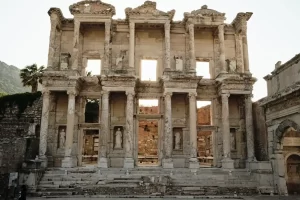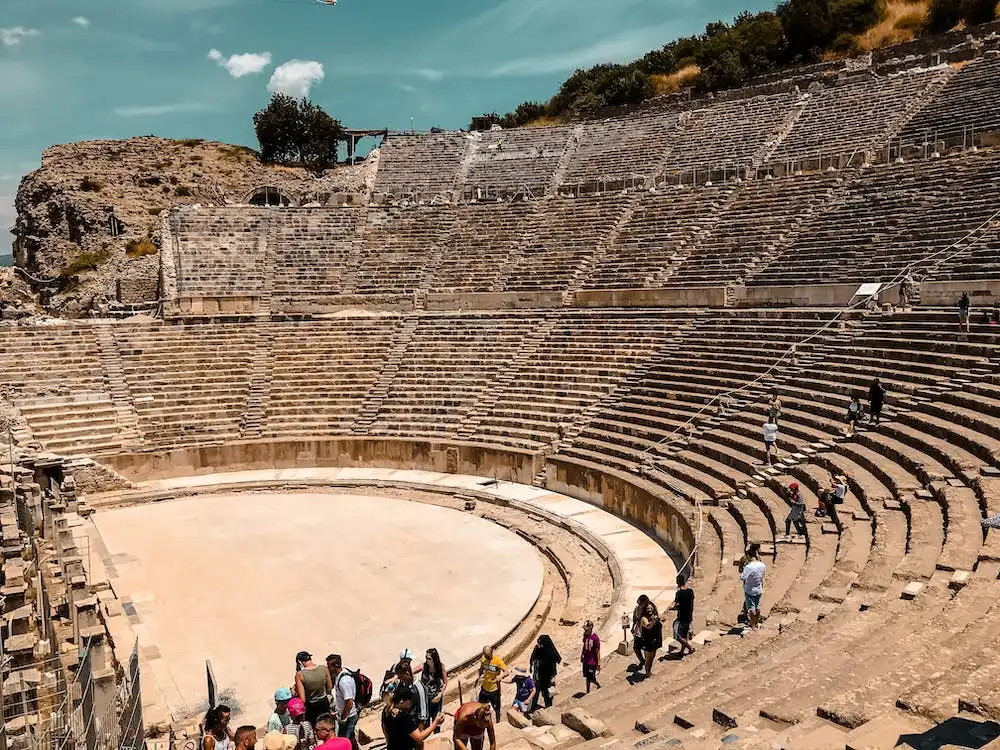Ephesus
Ephesus was an ancient Greek city located on the west coast of modern-day Turkey. It was one of the most important cities in the Roman Empire and was known for its impressive architecture, including the Temple of Artemis (one of the Seven Wonders of the Ancient World), the Library of Celsus, and the Great Theatre. The city was also a center of early Christianity and was the site of several early Christian churches, including the Church of Mary. Today, much of the ancient city of Ephesus has been excavated and is open to visitors, providing a glimpse into the history and culture of the ancient world.
Where is Ephesus Ancient City?
Ephesus Ancient City is located in modern-day Turkey, on the west coast near the Aegean Sea. Specifically, it is situated in the Selçuk district of İzmir province, near the city of Selçuk.
Who was Ephesus Ancient City Founded by?
The ancient city of Ephesus was founded by the Ionian Greeks. The city was originally a Greek settlement, but it later became part of the Roman Empire and was an important center of trade, culture, and religion for many centuries.
When Was the Ancient City of Ephesus Founded?
The ancient city of Ephesus was founded in the 10th century BCE.
Parts of the Ancient City of Ephesus
- Harbor Street: A main street leading from the harbor to the city center. The longest street of the ancient city of Ephesus. It connects the Odeon and the Ancient Harbor. Kings who came to the city in time were greeted on this street, religious ceremonies were held on this road.
- Ephesus Antique Theater (Grand Theatre): A large open-air theater that could seat up to 25,000 spectators.The stage of the theater is unfortunately in ruins, but the seating areas are in good condition. The theater is very important for Christianity as it is the place where St. Paul’s sermons take place.
- Commercial Agora: A marketplace and commercial center of the city.
- Temple of Serapis: Behind the Celsus Library is the Temple of Serapis. The temple was converted into a church during the Christian era, but inscriptions found in the excavations here revealed that the temple was actually dedicated to Serapis.
- Celsus Library: A magnificent library built in honor of Julius Celsus, a prominent Roman Senator. Celsus Library M.S. It was built by his son on behalf of Celsius, the governor of Ephesus, who died in 106. Although the library has a two-storey appearance from the outside, it is a single-storey building with high ceilings from the inside.
- Mazeus Gate: One of the city gates in Ephesus.
- Mazeus Mithridates: A monument dedicated to Mithridates, a king of Pontus and a ruler of the Roman province of Asia.
- Marble Street: A street in Ephesus lined with marble and featuring public buildings and shops.
- Love House: It is considered to be the brothel of the love house period. The love house is thought to have underground connections with secret passages from many structures in the city.
- Hillside Houses: Residential areas located on the hills surrounding the city center.
- Public Toilet (Latrina): A public restroom in ancient Ephesus, similar to a modern day public restroom. At that time, public toilets were used for socializing.
- Scholastic Baths: Public baths for socializing and hygiene. Baths, M.S. It is known that it was restored by a Christian woman named Scholastikia in the 400s. That’s why it’s called the Scholastika Baths. It consists of 4 sections as hot water room, warm water room, cold water room and locker room.
- Mosaic Pavement: Decorative flooring made from small, flat pieces of colored stone or glass, often used in public buildings and private residences in ancient Ephesus.
- Hadrian’s Temple: A temple dedicated to the Roman Emperor Hadrian. There are reliefs of Tike and Medusa, the goddess of luck, on its door.
- Trajan’s Fountain:A monumental fountain dedicated to the Roman Emperor Trajan.
- Curetes Street: A main street in the city lined with shops, public buildings, and houses.
- Heracles Gate: One of the city gates, possibly dedicated to the mythological hero Heracles.
- Memmius Monument: A monument dedicated to Gaius Memmius, a Roman politician and consul.
- Temple of Domitian: A temple dedicated to the Roman Emperor Domitian.
- Town Hall (Prytaneion): The city hall of Ephesus, where the council of the city met and held public events.
- Odeon: A small theater used for musical performances and political assemblies.

Which Civilizations Lived in the Ancient City of Ephesus?
The ancient city of Ephesus, located in modern-day Turkey, was inhabited by several civilizations throughout its history, including:
- The Hittites: An ancient Anatolian civilization that lived in the area around 1600 BCE.
- The Ionians: A group of ancient Greeks who established the city of Ephesus in the 10th century BCE.
- The Persians: An ancient Iranian civilization that conquered the city of Ephesus in the 6th century BCE.
- The Romans: An ancient Mediterranean civilization that conquered the city of Ephesus in the 2nd century BCE and made it a center of trade and commerce.
- The Byzantine Empire: The continuation of the Roman Empire after its division in the 4th century CE.
- The Ottoman Empire: A Muslim empire that controlled the city of Ephesus from the 15th century CE until the 20th century.
Throughout its history, the city of Ephesus was also influenced by other civilizations, such as the Greeks, the Egyptians, and the Babylonians.
Features of the Ancient City of Ephesus
The ancient city of Ephesus, located in modern-day Turkey, was a thriving metropolis in the ancient world and had several notable features, including:
- Advanced Architecture: The city was known for its impressive public buildings and monuments, including temples, theaters, libraries, and bathhouses, that were constructed using advanced architectural techniques.
- Urban Planning: The city was well-planned, with a grid-like street pattern and designated areas for different functions, such as residential, commercial, and religious.
- Harbor and Trade: The city was located on the Aegean coast and had a large natural harbor that was an important center of trade and commerce, connecting Ephesus to the wider Mediterranean world.
- Rich Culture and History: The city was home to a diverse population and had a rich cultural and historical heritage, including links to the ancient Greek and Roman civilizations, as well as numerous myths and legends.
- Advanced Engineering: The city was equipped with advanced engineering systems, such as aqueducts for water supply, sewage systems for waste management, and roads for transportation.
- Art and Decoration: The city was adorned with beautiful artwork and decorative elements, including statues, reliefs, mosaics, and fountains, that adorned its public buildings and private residences
The Story of the Ancient City of Ephesus
The story of the ancient city of Ephesus, located in modern-day Turkey, spans thousands of years and is intertwined with the history of several civilizations and cultures.
The city was founded by the Ionian Greeks in the 10th century BCE and became an important center of trade and commerce. Over the centuries, the city was conquered by various powers, including the Persians and the Romans. During the Roman period, Ephesus became a major city in the province of Asia and was known for its impressive public buildings, including the Temple of Artemis, one of the Seven Wonders of the Ancient World.
In the 4th century CE, the Roman Empire was divided into two parts, and Ephesus became part of the Eastern, or Byzantine, Empire. Despite several invasions by barbarian tribes, the city continued to thrive and was an important center of Christianity.
In the 15th century, the Ottoman Turks conquered the city and ruled it until the 20th century. Over time, the city declined and was largely abandoned, with much of its buildings and monuments lost to the elements and looting.
In recent times, extensive archaeological work has been carried out at the site of ancient Ephesus, and many of its structures and monuments have been restored and preserved. Today, the ancient city of Ephesus is a popular tourist destination and a testament to the rich cultural and historical heritage of the region.
The Legend of the Ancient City of Ephesus
The ancient city of Ephesus, located in modern-day Turkey, was associated with several legends and myths throughout its long history. Some of the most famous legends include:
The Temple of Artemis: According to legend, the Temple of Artemis, one of the Seven Wonders of the Ancient World, was built in honor of the goddess Artemis. It was said to have been a magnificent temple that attracted visitors and pilgrims from all over the ancient world.
The Amazons: Legend has it that the city of Ephesus was founded by the Amazon Queen Hippolyta and her followers. The Amazons were a tribe of female warriors who were said to have lived in the region and played a role in the history of the city.
The Ephesian Artemis: According to legend, the goddess Artemis was said to have been born in Ephesus and was revered by the citizens of the city as their patron goddess. She was said to have protected the city and its people, and her temple was considered one of the most important places of worship in the ancient world.
St. John the Evangelist: Legend has it that St. John the Evangelist, one of the twelve apostles of Jesus, lived and died in Ephesus. The city is also associated with the Virgin Mary, who is said to have spent the last years of her life in the region.
These legends and myths have played a significant role in shaping the cultural and religious identity of the ancient city of Ephesus and continue to be a source of fascination for people today.
How to Get to the Ancient City of Ephesus?
The ancient city of Ephesus is located near the modern-day town of Selçuk in western Turkey. There are several ways to get there:
- By Air: The closest airport is İzmir Adnan Menderes Airport, which is about 50 miles from Selçuk. From the airport, you can take a taxi or rent a car to reach Selçuk.
- By Bus: There are regular bus services from İzmir and other cities in Turkey that stop in Selçuk. From Selçuk, you can take a taxi or walk to the ancient city of Ephesus.
- By Train: The closest train station is in İzmir, and from there you can take a bus or taxi to Selçuk.
- By Cruise: If you are visiting the Aegean coast of Turkey, you may be able to take a cruise that stops at the nearby port of Kuşadası, from where you can take a bus or taxi to Selçuk and the ancient city of Ephesus.
Once you reach Selçuk, you can visit the ancient city of Ephesus as a day trip or stay overnight in the town. There are several tours available that will take you to the ancient city, or you can explore it on your own. Note that some parts of the site are quite extensive, so be prepared for some walking.
Is there an entrance fee to the Ancient City of Ephesus?
Yes, there is an entrance fee to visit the ancient city of Ephesus in Turkey. The fee is set by the Turkish government and is subject to change. As of my knowledge cutoff (202), the fee for a single adult ticket was around 150 Turkish Lira (approximately $7.5 USD). The fee includes access to several parts of the ancient city, including the Library of Celsus, the Odeon, the Roman Baths, the Temple of Hadrian, and the Great Theater. There are also separate fees for other nearby sites and museums.
It is advisable to check with the local tourist authorities for the most up-to-date information on entrance fees and ticket prices before your visit. Some tour packages may also include the entrance fee as part of the cost, so it is worth checking with your tour operator.
Attractions Near Ephesus Ancient City
The ancient city of Ephesus, located in modern-day Turkey, is surrounded by many other historical and cultural attractions that are worth visiting. Here are some of the most popular attractions near the ancient city of Ephesus:
The House of the Virgin Mary: Located on a hillside near Ephesus, this small shrine is believed to be the final resting place of the Virgin Mary, the mother of Jesus. It is a popular pilgrimage site for Christians and an important part of the region’s religious heritage.
The Temple of Artemis: Although the original Temple of Artemis, one of the Seven Wonders of the Ancient World, no longer exists, its remains can still be seen in the ancient city of Ephesus. The temple was dedicated to the goddess Artemis and was a major center of worship in the ancient world.
The Church of St. John: This ancient church, located near the ancient city of Ephesus, is believed to have been built over the final resting place of St. John the Evangelist, one of the twelve apostles of Jesus. It is an important site for Christian pilgrims and a unique example of early Christian architecture.
The Archaeological Museum of Selçuk: This museum, located in the nearby town of Selçuk, houses a collection of artifacts from the ancient city of Ephesus and other nearby sites, including mosaics, sculptures, and inscriptions. It provides a fascinating look at the history and culture of the region.
Şirince: You can visit the village of Şirince when you go to the ancient city of Ephesus. Şirince is a small village located about 6 miles from the town of Selçuk, which is near the ancient city of Ephesus in western Turkey. Şirince is known for its well-preserved traditional Ottoman architecture, its vineyards and wineries, and its stunning views of the surrounding countryside.
These attractions and many others make the ancient city of Ephesus and its surrounding region a rich and fascinating destination for tourists and history buffs.
You can see beautiful photos of Ephesus from Google Photos
You may also want to learn about Turkey’s highest mountain, Mount Ararat. Please click on the link to read more about majestic Mount Ararat.





